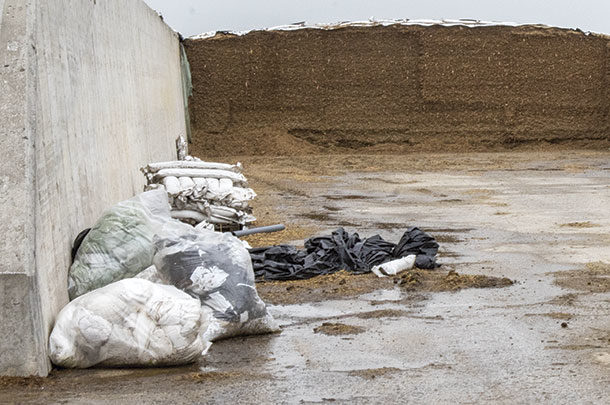Plastic recycling is an issue that concerns consumers in almost every industry, and agriculture is no different. A study released in 2011 found that Ontario farmers use nearly 7,000 tonnes of plastic as part of their yearly operations.
Of these 7,000 tonnes, plastic film such as silage film and bale wrap accounts for nearly half of this weight, Kim Timmer, a manager at Cleanfarms, a nonprofit organization that recycles agricultural plastics, explained. To address the sustainability of the use of plastic on farms, it helps to understand the farmer’s role in the recycling process and the value of recycling plastics, as well as the potential of bio-based plastics.
Preparing silage film and bale wrap plastics for recycling
Lynn Leavitt has been working towards proper disposal of farm plastics for over 11 years. After connecting with students and industry experts and understanding their concerns with agricultural plastic use and waste, he began to question what his role as a farmer could be in terms of finding a solution. “As farmers, lots of times we sit back, and we say, ‘Well, we’re not too happy with the way government does things.’ But I strongly believe we have an obligation to be part of the fix,” Leavitt said during the Ontario Forage Council’s “Post-Plastic Forage Storage Panel” held on Dec. 2. Leavitt, founder of U-Pac Agri Service, which markets bale plastic compactors, presented on the panel alongside Timmer and Dr. Erica Pensini, an assistant professor at the University of Guelph.
Leavitt’s goal was to create an efficient and cost-effective way to aid farmers with their recycling efforts. Using a simple wooden compactor, producers are able to compact their silage and bale wrap plastics and store them until they are able to transport them to a central recycling site, Leavitt explained.
“We had to see what we can do with the plastic and try to make it pay as much of the bills as possible,” he said. With this is mind, he reached out to the plastic manufacturers and presented them with the compacted plastic ready to be recycled. The company offered to pay Leavitt 6 cents per pound of plastic, a possibility that may exist for other producers.
To prepare the plastic for compacting and recycling, Leavitt suggested first folding a few plastic sheets and placing them at the bottom of the compactor. After this, the plastic can be loosely and evenly placed in the compactor to be compressed. He said the plastic, which is compressed using a plunger attached to a tractor, should be compacted until there is no spring back. The finished product should resemble a plastic bale tied with at least three strings to maintain its shape.
Leavitt noted it is important to maintain the integrity of the plastic, meaning there should be no debris such as mud left on or in the plastic once it is ready to be compacted. The plastic can then be tagged to be processed for recycling.
Stewardship and skepticism
“There’s a really strong sense of stewardship and doing the right thing in the farming community,” Timmer said. She noted this stewardship has played a major part in the success of many agricultural plastic recycling programs. Like Leavitt, Timmer stressed the importance of viewing used plastics as marketable product. “I want everyone to keep in mind that you’re not creating a pile for the sake of creating a pile; we are collecting a commodity,” Timmer said. “It’s a commodity that someone else is going to use to create a new product. We want to market a high-quality commodity.”
Timmer explained it is important for larger recycling organizations to enhance the work done by smaller recycling initiatives like Leavitt’s.
“While there’s a lot of interest in plastics recycling, we all need to be aware that there’s also some skepticism,” Timmer noted. She said whether producers are recycling through their municipality or a private partner, the organization should be able to explain what is done with their plastics as well as answer any questions regarding who, when, where and how the plastic is recycled.
Commonly, agricultural plastics – especially those used as pesticide containers – are recycled into drainage tile. This minimizes human contact with the product, and the resulting drainage tile is typically tested to ensure it does not leach contaminants into the soil.
The future of bio-based forage plastics
Even though recycling options exist and more continue to be developed, they require effort to enact. Additionally, challenges are often associated with the recycling process. To address this, new research is aimed at bio-based plastics, which are plastics not derived from fossil fuels.
Dr. Erica Pensini’s research focuses on creating these bio-based plastics in an effort to prevent contamination and potentially substitute them for conventional plastics.
Pensini noted it is difficult to compete with traditional plastics as they are low-cost, flexible and do not degrade.
Another concern with bio-based plastics is that they are often derived from materials which can be used for food. “There can be a conflict with the food supply chain,” Pensini said.
Pensini has been working to develop a bio-based material that can maintain its condition during its intended lifetime. To do this she has focused on zein, a protein found in corn that is also a corn byproduct and not something humans would consume. “It’s fairly inexpensive, and it also would perhaps allow us to obtain a product that can be [durable] in the field,” Pensini said. The zein can be used, relatively easily, to produce a bio-based plastic spray-on film, said Pensini. The film has been sprayed on fields and found to decrease moisture loss while allowing plants to grow, something Pensini said makes it promising for use in silage scenarios.
A challenge with these bio-based films, however, is: They are prone to losing their flexibility over time. In order to maintain flexibility, concerns over permeability increase. To improve this, Pensini has begun combining the zein plastic material with grape or tomato peel waste to create a waxy material that adds an additional layer of impermeability.
Pensini said work is still needed to understand how these materials can be produced on a large scale while maintaining performance and being cost-effective. However, she said producers and manufacturers should look beyond product costs when considering plastic options. “If you look at the overall costs, which is a cost that we are all kind of incurring because of, for instance, the fact that the soil gets degraded when microplastics are in it. Or the fact that we all have this warm winter, which is great, but honestly this is going to lead to scarcity of water resources. If we factor in those aspects, then you get the real cost,” she said.
While bio-based forage plastics are not yet a widely available option, minimizing the environmental impact of forage and other agricultural plastics is an issue that has a variety of solutions.










